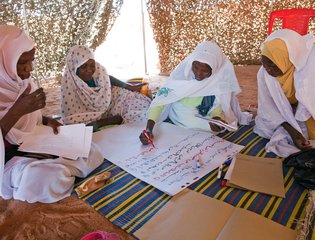Humanitarian need around the world is increasing – but funding from governments and institutional donors is not keeping pace. Now aid agencies are looking to a mixed group of new non-state funders in both established and emerging economies to fill the gap.
The new report 'Humanitarian assistance from non-state donors: What is it worth?' from the Global Humanitarian Assistance (GHA) programme of Development Initiatives paints a detailed picture of non-state humanitarian funding within this changing context. It shows where the money comes from, how it is raised, and where it is spent.
Based on the report, the five things you need to know about non-state humanitarian funding are:
- Private giving is an important source of money for humanitarian assistance
We estimate that US$4.1 billion was given in private funding in 2012, with over a quarter of all international humanitarian assistance coming from private donors between 2008 and 2012. But both institutional and private contributions have fallen yearly since 2010, with private donations falling more steeply (a drop of 26%, compared with just 7% in institutional funding).
2. Private fundraising efforts in new and emerging economies are shifting focus
We discovered humanitarian agencies are stepping up their private fundraising efforts in new and emerging economies, with Asia and the Middle East both playing important roles. For example, after Typhoon Haiyan hit, World Vision Philippines managed to raise US$1.7 million within the country itself to use for their responses.
3. UN agencies get an increasing amount of money from private sources
While most private funds come from individual people and are given to non-governmental organisations, UN agencies are now getting a lot more funding from private sources – and in their case especially from companies and corporations. In 2008, UN agencies got less than 1% of humanitarian funding from private companies, but by 2012 the share from this group of donors had gone up to 15%.
4. Non-state and institutional donors often support different types of crises
Our report also shows some startling differences in the types of crises supported by non-state donors. Since 1999, the average funding appeal raised by the UK’s Disasters Emergency Committee for conflict-related crises was £21 million, while natural disasters raised over three times more than this: on average £67 million.
5. Private funds are also spent in different places to institutional funds. For example, our report found that in 2012 Haiti was the top recipient of private funds, but was only the 15th highest recipient of bilateral government funding.
We critically need better data on non-state humanitarian funding. We believe the reporting of humanitarian funding needs to get better. The lack of available data on private funds comes up again and again in our report. A large group of organisations support our research in this area by directly providing us with data and information on their private humanitarian funding. We supplement this with data from publicly available sources such as annual reports. But this still doesn’t give us the full story.
We need information on all financial flows to be better reported so we can more clearly understand the total resources available. This would lead to a more coordinated response and help make sure that resources are allocated according to need. To achieve this, and greater accountability, coordination and efficiency in delivering humanitarian assistance, everyone – state and non-state – should publish their financial information to the International Aid Transparency Initiative (IATI) standard.


